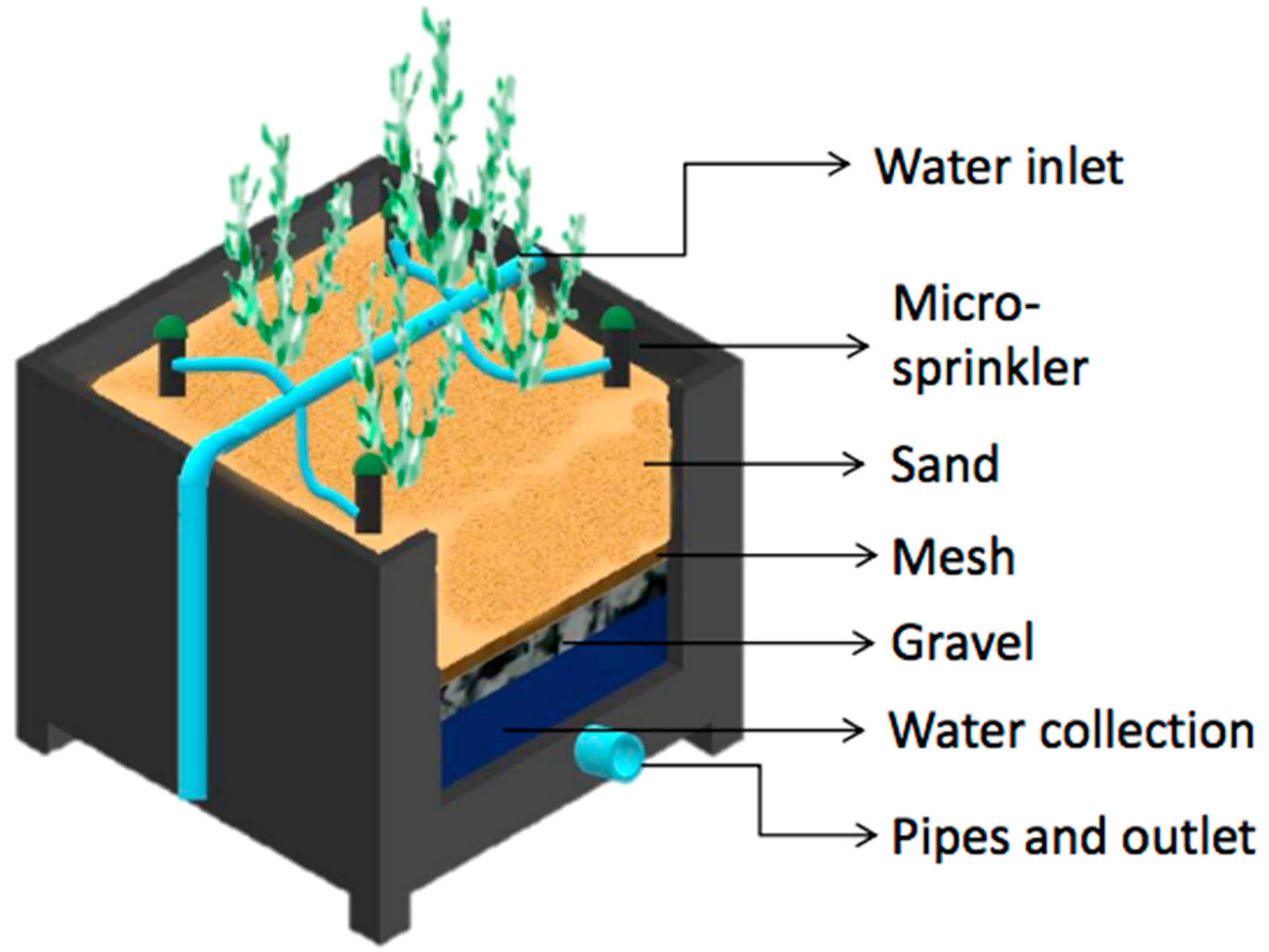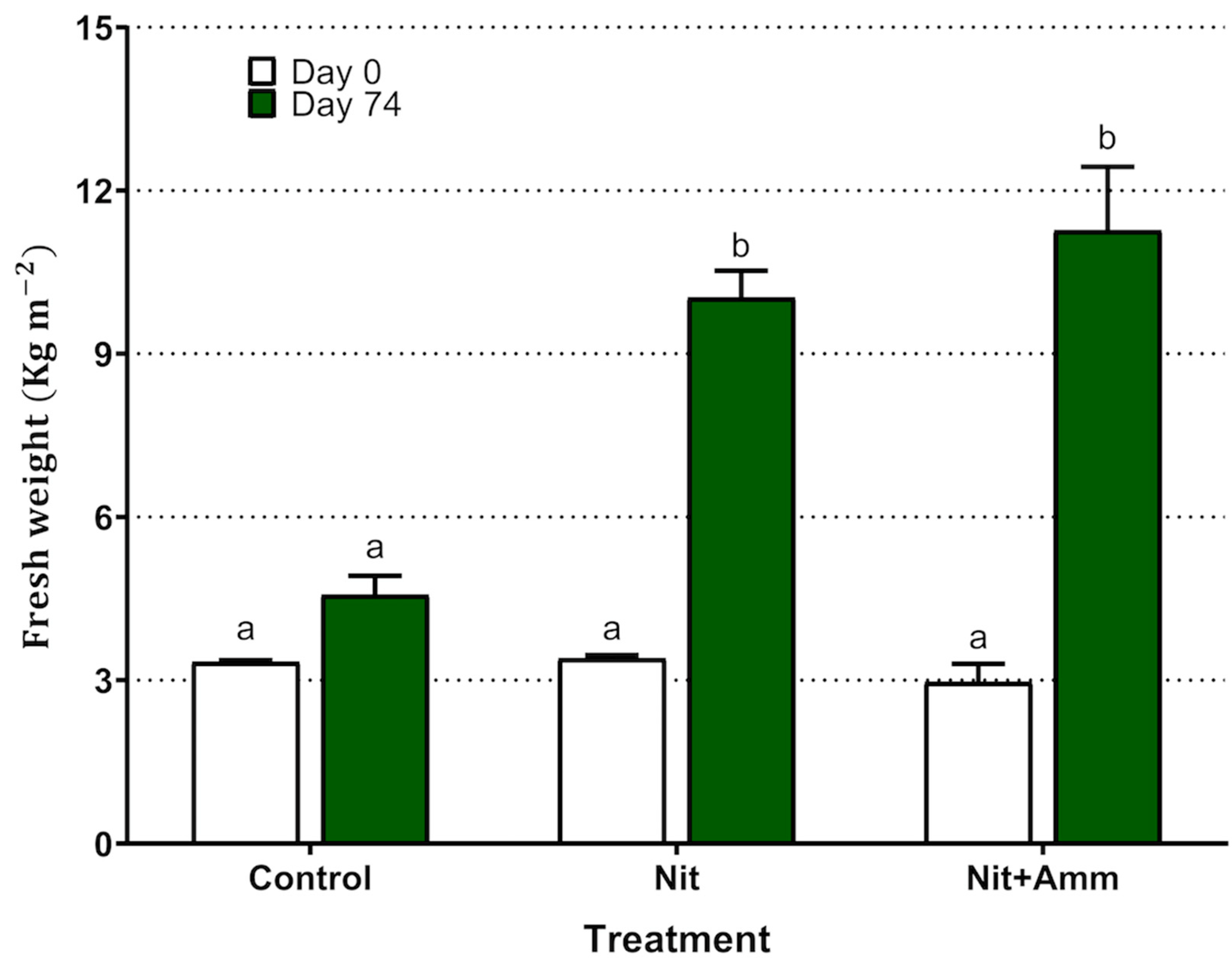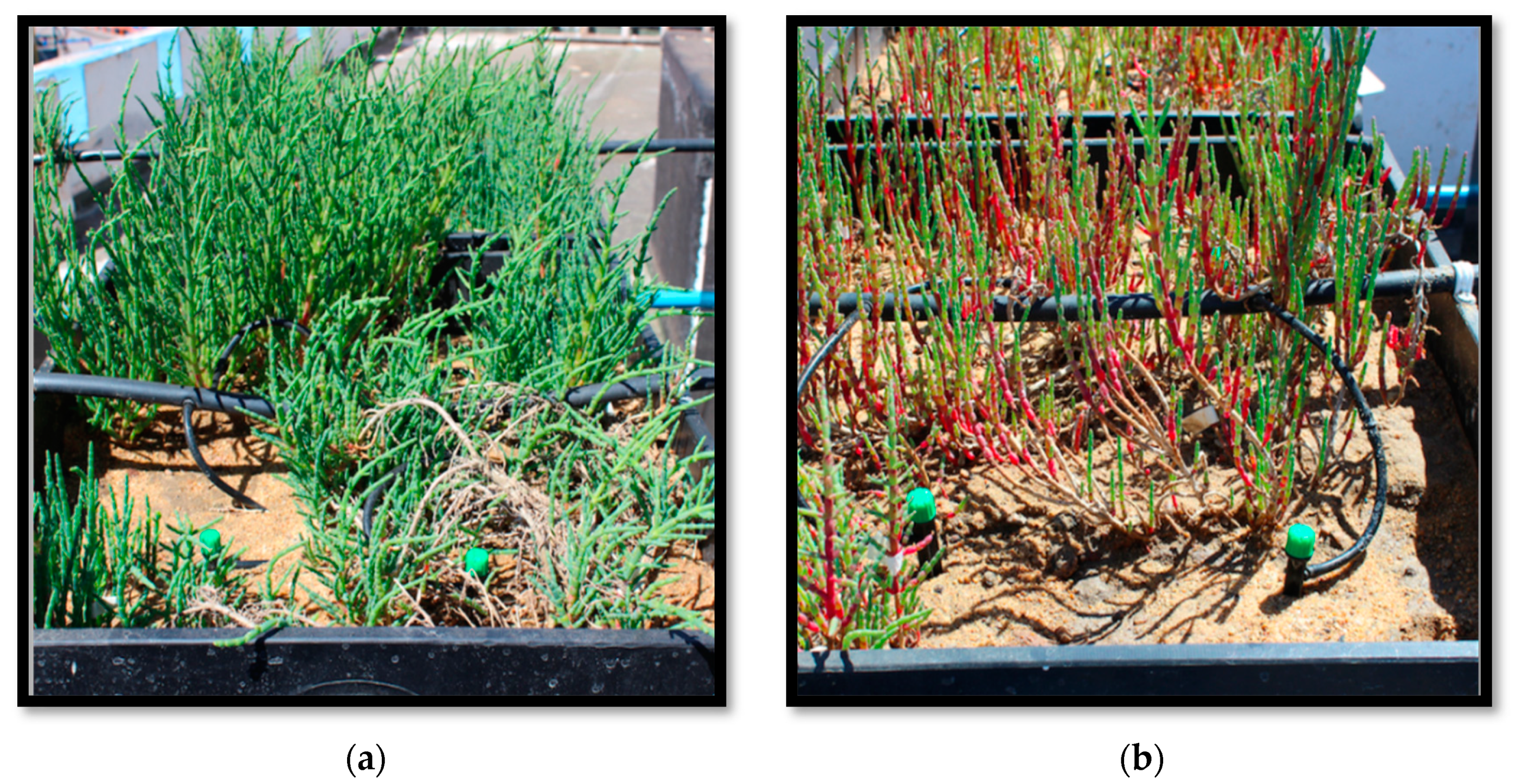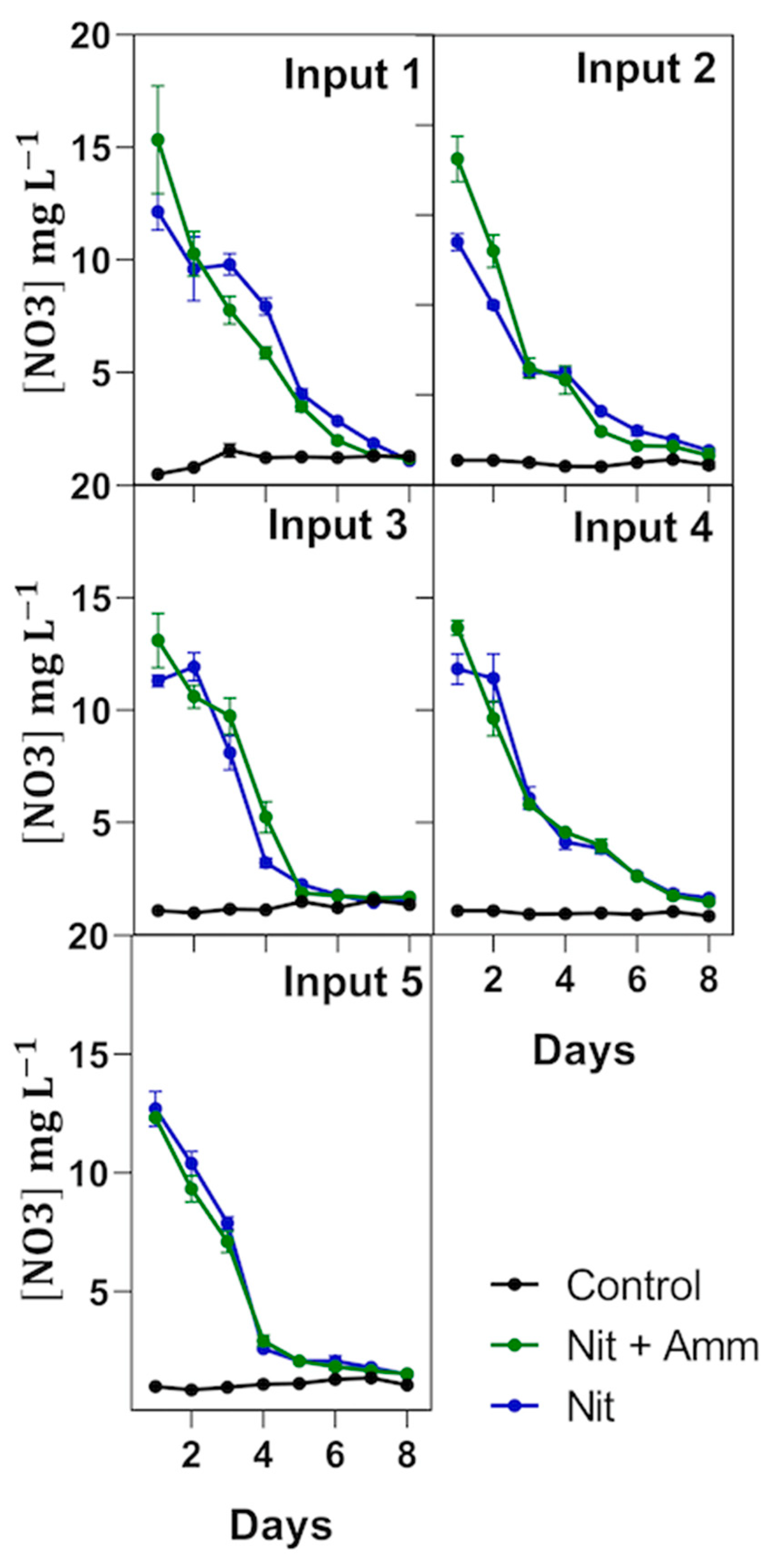Efficiency of Salicornia neei to Treat Aquaculture Effluent from a Hypersaline and Artificial Wetland
Abstract
1. Introduction
2. Materials and Methods
2.1. Collection of Plant Material and Acclimatization
2.2. Experimental Unit
2.3. Experimental Design
2.4. Statistical Analysis
3. Results
3.1. Environmental Conditions and RAS Parameters
3.2. Growth and Biomass Formation
3.3. Efficiency of Salicornia neei to Treat Saline Effluent
4. Discussion
5. Conclusions
Supplementary Materials
Author Contributions
Funding
Acknowledgments
Conflicts of Interest
References
- Tovar, A.; Moreno, C.; Manuel-Vez, M.P.; Garcia-Vargas, M. Environmental impacts of intensive aquaculture in marine waters. Water Res. 2000, 34, 334–342. [Google Scholar] [CrossRef]
- De Lange, H.J.; Paulissen, M.; Slim, P.A. Halophyte filters: The potential of constructed wetlands for application in saline aquaculture. Int. J. Phytoremediat. 2013, 15, 352–364. [Google Scholar] [CrossRef] [PubMed]
- Quinta, R.; Santos, R.; Thomas, D.N.; Le Vay, L. Growth and nitrogen uptake by Salicornia europaea and Aster tripolium in nutrient conditions typical of aquaculture wastewater. Chemosphere 2015, 120, 414–421. [Google Scholar] [CrossRef] [PubMed]
- Vymazal, J. Constructed wetlands for treatment of industrial wastewaters: A review. Ecol. Eng. 2014, 73, 724–751. [Google Scholar] [CrossRef]
- Boxman, S.E.; Nystrom, M.; Capodice, J.C.; Ergas, S.J.; Main, K.L.; Trotz, M.A. Effect of support medium, hydraulic loading rate and plant density on water quality and growth of halophytes in marine aquaponic systems. Aquac. Res. 2017, 48, 2463–2477. [Google Scholar] [CrossRef]
- Carballeira, C.; de Orte, M.R.; Viana, I.G.; Carballeira, A. Implementation of a minimal set of biological tests to assess the ecotoxic effects of effluents from land-based marine fish farms. Ecotox. Environ. Safe. 2012, 78, 148–161. [Google Scholar] [CrossRef]
- Shpigel, M.; Ben-Ezra, D.; Shauli, L.; Sagi, M.; Ventura, Y.; Samocha, T. Constructed wetland with Salicornia as a biofilter for mariculture effluents. Aquaculture 2013, 412, 52–63. [Google Scholar] [CrossRef]
- Zohar, Y.; Tal, Y.; Schreier, H.; Steven, C.; Stubblefield, J.; Place, A. 10 Commercially Feasible Urban Recirculating Aquaculture: Addressing the Marine Sector; Costa-Pierce, B., Desbonnet, A., Edwards, P., Baker, D., Eds.; CABI Publishing: Wallingford, UK, 2005; pp. 159–171. [Google Scholar]
- Gutierrez-Wing, M.T.; Malone, R.F. Biological filters in aquaculture: Trends and research directions for freshwater and marine applications. Aquac. Eng. 2006, 34, 163–171. [Google Scholar] [CrossRef]
- Kajimura, M.; Croke, S.J.; Glover, C.N.; Wood, C.M. Dogmas and controversies in the handling of nitrogenous wastes: The effect of feeding and fasting on the excretion of ammonia, urea and other nitrogenous waste products in rainbow trout. J. Exp. Biol. 2004, 207, 1993–2002. [Google Scholar] [CrossRef]
- Camargo, J.A.; Alonso, A. Ecological and toxicological effects of inorganic nitrogen pollution in aquatic ecosystems: A global assessment. Environ. Int. 2006, 32, 831–849. [Google Scholar] [CrossRef]
- Thoman, E.S.; Ingall, E.D.; Davis, D.A.; Arnold, C.R. A nitrogen budget for a closed, recirculating mariculture system. Aquac. Eng. 2001, 24, 195–211. [Google Scholar] [CrossRef]
- Orellana, J.; Waller, U.; Wecker, B. Culture of yellowtail kingfish (Seriola lalandi) in a marine recirculating aquaculture system (RAS) with artificial seawater. Aquac. Eng. 2014, 58, 20–28. [Google Scholar] [CrossRef]
- Brown, J.J.; Glenn, E.P.; Fitzsimmons, K.M.; Smith, S.E. Halophytes for the treatment of saline aquaculture effluent. Aquaculture 1999, 175, 255–268. [Google Scholar] [CrossRef]
- Webb, J.M.; Quinta, R.; Papadimitriou, S.; Norman, L.; Rigby, M.; Thomas, D.N. Halophyte filter beds for treatment of saline wastewater from aquaculture. Water Res. 2012, 46, 5102–5114. [Google Scholar] [CrossRef] [PubMed]
- Buhmann, A.; Papenbrock, J. Biofiltering of aquaculture effluents by halophytic plants: Basic principles, current uses and future perspectives. Environ. Exp. Bot. 2013, 92, 122–133. [Google Scholar] [CrossRef]
- Forde, B.G.; Clarkson, D.T. Nitrate and ammonium nutrition of plants: Physiological and molecular perspectives. Adv. Bot. Res. 1999, 30, 1–90. [Google Scholar]
- Cott, G.M.; Caplan, J.S.; Mozdzer, T.J. Nitrogen uptake kinetics and saltmarsh plant responses to global change. Sci. Rep. 2018, 8, 5393. [Google Scholar] [CrossRef]
- Hessini, K.; Ben Hamed, K.; Gandour, M.; Mejri, M.; Abdelly, C.; Cruz, C. Ammonium nutrition in the halophyte Spartina alterniflora under salt stress: Evidence for a priming effect of ammonium? Plant. Soil. 2013, 370, 163–173. [Google Scholar] [CrossRef]
- Jesus, J.M.; Cassoni, A.C.; Danko, A.S.; Fiuza, A.; Borges, M.T. Role of three different plants on simultaneous salt and nutrient reduction from saline synthetic wastewater in lab-scale constructed wetlands. Sci. Total Environ. 2017, 579, 447–455. [Google Scholar] [CrossRef]
- Panta, S.; Flowers, T.; Lane, P.; Doyle, R.; Haros, G.; Shabala, S. Halophyte agriculture: Success stories. Environ. Exp. Bot. 2014, 107, 71–83. [Google Scholar] [CrossRef]
- Riquelme, J.; Olaeta, J.A.; Galvez, L.; Undurraga, P.; Fuentealba, C.; Osses, A. Nutritional and functional characterization of wild and cultivated Sarcocornia neei grown in Chile. Cienc. Investig. Agrar. 2016, 43, 283–293. [Google Scholar] [CrossRef]
- Turcios, A.E.; Papenbrock, J. Sustainable treatment of aquaculture effluents-what can we learn from the Past for the future? Sustainability 2014, 6, 836–856. [Google Scholar] [CrossRef]
- Vymazal, J. Constructed wetlands for wastewater treatment. Ecol. Eng. 2005, 25, 475–477. [Google Scholar] [CrossRef]
- Webb, J.M.; Quinta, R.; Papadimitriou, S.; Norman, L.; Rigby, M.; Thomas, D.N. The effect of halophyte planting density on the efficiency of constructed wetlands for the treatment of wastewater from marine aquaculture. Ecol. Eng. 2013, 61, 145–153. [Google Scholar] [CrossRef]
- Quinta, R.; Hill, P.W.; Jones, D.L.; Santos, R.; Thomas, D.N.; Le Vay, L. Uptake of an amino acid (alanine) and its peptide (trialanine) by the saltmarsh halophytes Salicornia europaea and Aster tripolium and its potential role in ecosystem N cycling and marine aquaculture wastewater treatment. Ecol. Eng. 2015, 75, 145–154. [Google Scholar] [CrossRef]
- Waller, U.; Buhmann, A.K.; Ernst, A.; Hanke, V.; Kulakowski, A.; Wecker, B. Integrated multi-trophic aquaculture in a zero-exchange recirculation aquaculture system for marine fish and hydroponic halophyte production. Aquac. Int. 2015, 23, 1473–1489. [Google Scholar] [CrossRef]
- Valladao, G.M.R.; Gallani, S.U.; Pilarski, F. South American fish for continental aquaculture. Rev. Aquac. 2018, 10, 351–369. [Google Scholar] [CrossRef]
- Alonso, M.F.; Orellana, C.; Valdes, S.; Diaz, F.J. Effect of salinity on the germination of Sarcocornia neei (Chenopodiaceae) from two contrasting habitats. Seed Sci. Technol. 2017, 45, 252–258. [Google Scholar] [CrossRef]
- De Souza, M.M.; Mendes, C.R.; Doncato, K.B.; Badiale-Furlong, E.; Costa, C.S.B. Growth, phenolics, photosynthetic pigments, and antioxidant response of two new genotypes of sea Asparagus (Salicornia neei Lag.) to salinity under greenhouse and field conditions. Agriculture 2018, 8, 115. [Google Scholar] [CrossRef]
- De Lange, H.J.; Paulissen, M. Efficiency of three halophyte species in removing nutrients from saline water: A pilot study. Wetl. Ecol. Manag. 2016, 24, 587–596. [Google Scholar] [CrossRef]
- Lin, Y.F.; Jing, S.R.; Lee, D.Y.; Wang, T.W. Nutrient removal from aquaculture wastewater using a constructed wetlands system. Aquaculture 2002, 209, 169–184. [Google Scholar] [CrossRef]
- Team R.C. R: A Language and Environment for Statistical Computing, R Foundation for Statistical Computing. Available online: https://www.R-project.org/ (accessed on 31 March 2020).
- El Shaer, H.M. Halophytes and salt-tolerant plants as potential forage for ruminants in the Near East region. Small. Ruminant. Res. 2010, 91, 3–12. [Google Scholar] [CrossRef]
- Alonso, M.A.; Crespo, M.B. Taxonomic and nomenclatural notes on South American taxa of Sarcocornia (Chenopodiaceae). Ann. Bot. Fenn. 2008, 45, 241–254. [Google Scholar] [CrossRef]
- Liang, Y.X.; Zhu, H.; Banuelos, G.; Yan, B.X.; Zhou, Q.W.; Yu, X.F. Constructed wetlands for saline wastewater treatment: A review. Ecol. Eng. 2017, 98, 275–285. [Google Scholar] [CrossRef]
- Lee, C.G.; Fletcher, T.D.; Sun, G.Z. Nitrogen removal in constructed wetland systems. Eng. Life. Sci. 2009, 9, 11–22. [Google Scholar] [CrossRef]
- Freedman, A.; Gross, A.; Shelef, O.; Rachmilevitch, S.; Arnon, S. Salt uptake and evapotranspiration under arid conditions in horizontal subsurface flow constructed wetland planted with halophytes. Ecol. Eng. 2014, 70, 282–286. [Google Scholar] [CrossRef]
- Rathore, A.P.; Chaudhary, D.R.; Jha, B. Biomass production, nutrient cycling, and carbon fixation by Salicornia brachiata Roxb.: A promising halophyte for coastal saline soil rehabilitation. Int. J. Phytoremediat. 2016, 18, 801–811. [Google Scholar]
- Hachiya, T.; Sakakibara, H. Interactions between nitrate and ammonium in their uptake, allocation, assimilation, and signaling in plants. J. Exp. Bot. 2017, 68, 2501–2512. [Google Scholar] [CrossRef]
- Kadlec, R.H.; Wallace, S. Treatment Wetlands; CRC Press (Lewis Publishers): Boca Raton, FL, USA, 2008; pp. 257–347. [Google Scholar]
- Margesin, R.; Schinner, F. Potential of halotolerant and halophilic microorganisms for biotechnology. Extremophiles 2001, 5, 73–83. [Google Scholar] [CrossRef]
- Tanner, C.C.; Kadlec, R.H.; Gibbs, M.M.; Sukias, J.P.S.; Nguyen, M.L. Nitrogen processing gradients in subsurface-flow treatment wetlands-influence of wastewater characteristics. Ecol. Eng. 2002, 18, 499–520. [Google Scholar] [CrossRef]
- Ventura, Y.; Wuddineh, W.A.; Myrzabayeva, M.; Alikulov, Z.; Khozin-Goldberg, L.; Shpigel, M. Effect of seawater concentration on the productivity and nutritional value of annual Salicornia and Perennial Sarcocomia halophytes as leafy vegetable crops. Sci. Hortic. 2011, 128, 189–196. [Google Scholar] [CrossRef]
- Raab, T.; Terry, N. Nitrogen source regulation of growth and photosynthese in Beta vulgaris L. Plant. Physiol. 1994, 10, 1159–1166. [Google Scholar] [CrossRef] [PubMed]




| Treatment | Input | Temperature (°C) | pH | |
|---|---|---|---|---|
| Nit + Amm | 1 | 18.2 ± 4.2 | 8.2 ± 0.1 | 40.6 ± 2.2 |
| 2 | 18.8 ± 1.6 | 8.1 ± 0.1 | 44.9 ± 2.3 | |
| 3 | 20.8 ± 0.6 | 7.9 ± 0.1 | 48.5 ± 2.5 | |
| 4 | 20.2 ± 1.2 | 8.0 ± 0.1 | 47.5 ± 1.9 | |
| 5 | 20.6 ± 0.6 | 8.0 ± 0.1 | 48.0 ± 2.2 | |
| Nit | 1 | 19.5 ± 4.7 | 8.2 ± 0.1 | 41.3 ± 1.9 |
| 2 | 21.7 ± 3.3 | 8.1 ± 0.1 | 48.4 ± 2.2 | |
| 3 | 21.2 ± 0.8 | 7.9 ± 0.1 | 48.8 ± 3.2 | |
| 4 | 20.6 ± 1.4 | 8.0 ± 0.1 | 47.5 ± 2.1 | |
| 5 | 20.9 ± 0.7 | 7.9 ± 0.1 | 47.7 ± 2.4 | |
| Control | 1 | 19.1 ± 4.3 | 8.2 ± 0.1 | 40.0 ± 0.0 |
| 2 | 18.6 ± 1.5 | 8.0 ± 0.1 | 43.6 ± 2.1 | |
| 3 | 20.8 ± 0.5 | 8.0 ± 0.1 | 43.6 ± 2.1 | |
| 4 | 20.3 ± 1.2 | 8.2 ± 0.1 | 46.5 ± 2.6 | |
| 5 | 20.7 ± 0.5 | 8.2 ± 0.1 | 46.5 ± 1.6 |
| Treatment | Input | RE (%) | ||||
|---|---|---|---|---|---|---|
| Nit + Amm | 1 | 14.0 ± 4.2 | 1.2 ± 0.1 | 91.4 | 2.9 ± 0.5 | 1.2 ± 0.1 |
| 2 | 17.7± 2.2 | 1.8 ± 0.7 | 89.8 | 2.0 ± 0.3 | 0.3 ± 0.1 | |
| 3 | 13.5± 0.6 | 1.1 ± 0.05 | 91.9 | 3.1 ± 0.3 | 0,8 ± 0.1 | |
| 4 | 12.9 ± 2.1 | 1.7 ± 0.1 | 86.8 | 3.6 ± 0.5 | 0.0 ± 0.0 | |
| 5 | 12.4 ± 0.1 | 1.5 ± 0.1 | 87.9 | 3.0 ± 0.2 | 0.0 ± 0.0 | |
| Mean | 89.6 ± 1.0 | 2.3 ± 0.4 | 0.5 ± 0.2 | |||
| Nit | 1 | 12.0 ± 1.4 | 1.1 ± 0.1 | 90.8 | 1.1 ± 0.5 | 1.4 ± 0.1 |
| 2 | 13.3 ± 0.8 | 1.8 ± 0.2 | 86.5 | 1.2 ± 0.3 | 0.6 ± 0.1 | |
| 3 | 12.4 ± 1.2 | 1.2 ± 0.15 | 90.3 | 2.8 ± 0.3 | 0.7 ± 0.1 | |
| 4 | 13.2 ± 1.0 | 1.6 ± 0.1 | 87.9 | 3.7 ± 0.5 | 0.2 ± 0.0 | |
| 5 | 13.0 ± 1.3 | 1.5 ± 0.0 | 88.5 | 3.3 ± 0.2 | 0.0 ± 0.0 | |
| Mean | 88.8 ± 0.9 | 2.9 ± 0.5 | 0.4 ± 0.2 |
Publisher’s Note: MDPI stays neutral with regard to jurisdictional claims in published maps and institutional affiliations. |
© 2020 by the authors. Licensee MDPI, Basel, Switzerland. This article is an open access article distributed under the terms and conditions of the Creative Commons Attribution (CC BY) license (http://creativecommons.org/licenses/by/4.0/).
Share and Cite
Diaz, M.R.; Araneda, J.; Osses, A.; Orellana, J.; Gallardo, J.A. Efficiency of Salicornia neei to Treat Aquaculture Effluent from a Hypersaline and Artificial Wetland. Agriculture 2020, 10, 621. https://doi.org/10.3390/agriculture10120621
Diaz MR, Araneda J, Osses A, Orellana J, Gallardo JA. Efficiency of Salicornia neei to Treat Aquaculture Effluent from a Hypersaline and Artificial Wetland. Agriculture. 2020; 10(12):621. https://doi.org/10.3390/agriculture10120621
Chicago/Turabian StyleDiaz, Mónica R., Javier Araneda, Andrea Osses, Jaime Orellana, and José A. Gallardo. 2020. "Efficiency of Salicornia neei to Treat Aquaculture Effluent from a Hypersaline and Artificial Wetland" Agriculture 10, no. 12: 621. https://doi.org/10.3390/agriculture10120621
APA StyleDiaz, M. R., Araneda, J., Osses, A., Orellana, J., & Gallardo, J. A. (2020). Efficiency of Salicornia neei to Treat Aquaculture Effluent from a Hypersaline and Artificial Wetland. Agriculture, 10(12), 621. https://doi.org/10.3390/agriculture10120621






